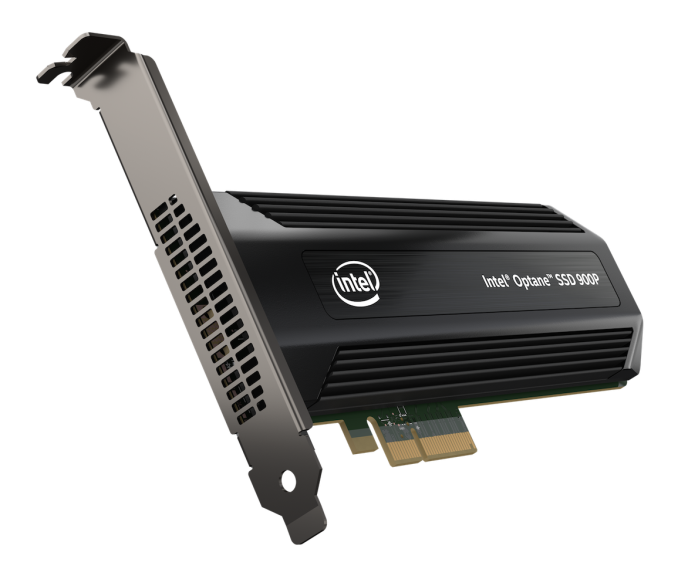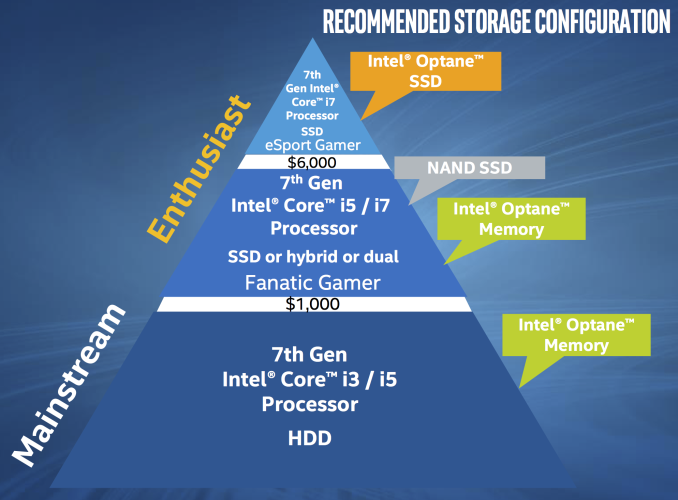The Intel Optane SSD 900P 280GB Review
by Billy Tallis on October 27, 2017 9:30 AM EST
Whenever Intel develops a new generation of SSDs based entirely on in-house technology, the result is usually a product that turns heads. Several times, Intel has set a new standard for SSD performance, starting with its original X25-M. Their most recent shake-up of the consumer SSD market was the Intel SSD 750, the first consumer NVMe SSD. Such significant releases don't happen every year, and in the intervening years Intel's competitors always catch up and surpass Intel.
However this year's revolution from Intel will be very hard for the competition to match anytime soon. All of Intel's previous record-setting SSDs have relied on the drive's controller to stand out from the crowd. This time, Intel's advantage comes from the storage medium: its 3D XPoint memory technology, a new nonvolatile memory that offers much higher performance than flash memory.
The Intel Optane SSD 900P
The new Intel Optane SSD 900P is a premium NVMe PCIe SSD offering the highest level of performance, with a moderate capacity. The Optane SSD 900P is intended for high-end desktop systems and workstations with very disk-heavy workloads. The Optane SSD 900P isn't for everyone and won't be displacing any existing products - it exists alone in a new product tier, with prices that are more than twice what the fastest flash memory based SSDs are selling for.
Optane is Intel's brand name for products featuring 3D XPoint memory. The Intel Optane SSD 900P is actually the third Optane product to be released, but it's the first family member to go after the high end consumer market segment. The Intel Optane Memory M.2 drives released earlier this year have capacities far too small for general-purpose storage use and instead have been marketed for use as a cache device to be paired with a mechanical hard drive. Intel's caching strategy works and can bring a hard drive's responsiveness up to the level of mainstream SSDs, but it has downsides. The Optane Memory caching requires a few extra steps to setup, and the caching software will only run on Intel platforms introduced this year: Kaby Lake or newer.
The Optane SSD DC P4800X is Intel's flagship enterprise SSD, and it is priced accordingly—putting it far out of reach of consumer budgets, and even with a price tag of over $1500 for 375GB it has been quite difficult to acquire. In the enterprise storage market, the P4800X has been highly sought after, but it isn't appropriate for all use cases and is not a threat to the many enterprise SSDs that prioritize capacity over performance and endurance.
The Optane SSD 900P will still cause some sticker shock for consumers expecting prices in line with M.2 PCIe SSDs, but it is acceptable for the kinds of machines that might be packing multiple GPUs or 10+ CPU cores. The Optane SSD 900P probably wouldn't be the only drive in such a system, but it would work well as a blazing fast primary storage device.
| Intel Optane SSD 900P Specifications | ||
| Capacity | 280 GB | 480 GB |
| Controller | Intel SLL3D | |
| Memory | Intel 128Gb 3D XPoint | |
| Interface | PCIe 3.0 x4 | |
| Form Factor | HHHL Add-in card or 2.5" 15mm U.2 |
HHHL Add-in card |
| Sequential Read | 2500 MB/s | |
| Sequential Write | 2000 MB/s | |
| Random Read IOPS | 550k | |
| Random Write IOPS | 500k | |
| Power Consumption | 8W Read 13W Write 14W Burst 5W Idle |
|
| Write Endurance | 10 DWPD | |
| Warranty | 5 years | |
| Recommended Price | $389 ($1.39/GB) | $599 ($1.25/GB) |
The Intel Optane SSD 900P is initially launching with 280GB and 480GB capacities. Both sizes will be available as PCIe 3.0 x4 half-height half-length add-in cards, and the 280GB model is also available as a 2.5" U.2 drive. Higher capacities may be added later, but Intel isn't promising anything yet. The sequential transfer speeds are nothing special for a NVMe SSD these days—Samsung's 960 PRO can hit much higher read speeds and slightly higher write speeds. The random read and write IOPS are far higher than any consumer SSD has offered before.
Intel's specifications for power consumption show one big reason why the Optane SSD 900P is a desktop-only product. Laptops are not equipped to supply up to 14W to a SSD, and they usually aren't equipped to cool a drive that idles at 5W instead of 50mW. The level of performance offered by the Optane SSD 900P cannot currently fit within the power budget or space constraints of a M.2 card.
The five year warranty Intel offers is typical for a high-end SSD in today's market, but doesn't compare to the 10 year warranty that Samsung's flagship 850 PRO SATA SSD offers. On the other hand, the 10 drive writes per day write endurance rating is far higher than most consumer SSDs get; 0.3 DWPD is more typical.
The Intel Optane SSD 900P starts shipping worldwide today, and here is our review of the 280GB version.











205 Comments
View All Comments
ddriver - Friday, October 27, 2017 - link
"MLC/TLC NAND treated like SLC"That sounds like "a snail treated as a cheetah". I bet feeding antelopes to a snail will make it as fast as a cheetah.
There is already a huge gap in access performance between MLC and TLC. TLC drives turn pathetic the moment they run out of cache. It is physically impossible to store multiple bits and access as if it is a single bit. Neither in terms of performance, nor in terms of endurance.
We haven't even seen what SLC is truly capable of, only the very early SSDs had SLC, and back then they were crippled by the primitive and tremendously under-powered controllers. At the medium level, SLC is insanely fast.
MFinn3333 - Friday, October 27, 2017 - link
OK, no that is simply not true.Fujtisu made a drive in 2014 entirely of Intel 25nm SLC and a Sandforce 2281 controller. It was called Fujitsu FSX 240GB (And 120GB). It kicked ass for it's class and time but it is nowhere and I mean nowhere near the speeds that are here or what you are claiming.
I set a couple of them up in RAIeD-0 through both hardware and software RAID and while it did often saturat the bandwidth but only with sequential transfers. The only number that it could ever come close to matching anything here is when you are talking random writes. I could easily hit 220MB/s at 4K Random Write but it's Random Read speed was around 50MB/s at the best of times.
SLC was and is awesome and I feel comfortable with doing horrible things to those drives (I defragged them for no reason, compiled code, did multiple virtual machines including Windows 3.11, and more benchmarking than any person ever should) but it's time is over.
Get over it.
ddriver - Friday, October 27, 2017 - link
Oh wow, you are some kind of a tech genius, expecting raid to boost something other than sequential access.2014 is ancient history in the world of SSD controllers. SLC on the physical level is capable of 500-600 times better performance than what the "best" SLC controller could squeeze out of it.
I am not saying this isn't the case for xpoint as well, I am just saying SLC is far more capable than what people can imagine.
MFinn3333 - Friday, October 27, 2017 - link
"We haven't even seen what SLC is truly capable of, only the very early SSDs had SLC, and back then they were crippled by the primitive and tremendously under-powered controllers. "That is what you wrote, not about SSD's a few years ago but the very early ones. You moved your own goalposts.
SLC is about 4x faster than MLC. You are claiming it to be 500x while showing little to no evidence and roasting Intel for their claims. So either put up or shut up with your evidence.
Reflex - Friday, October 27, 2017 - link
SLC does not obey physics. Gotta take that into account. ;)chrnochime - Wednesday, November 1, 2017 - link
No comment when the other guy mentions 2014 is not "very early SSD"? Come on now. Your prejudice against anything other than SLC is showing. We all know early SSDs go back much earlier than even 2007.edzieba - Saturday, October 28, 2017 - link
If SLC were truly better and cheaper than PCM, then companies would be using it and undercutting the competition with their cheaper, faster drives with lower production costs.jospoortvliet - Friday, November 3, 2017 - link
Indeed: https://xkcd.com/808/extide - Friday, October 27, 2017 - link
Regardless of the tests used here this thing is one of the fastest storage devices available PERIOD, and it's honestly priced pretty well. It's cheaper/GB than the first SSD I bought, in fact. I could see this being used for large swaps on servers that need a huge memory footprint for a lot cheaper than a shitload of RAM, or as a ZFS L2ARC or ZIL, or for hosting a ton of VM's or for running databases off of, etc.BUT you are ddriver, the king of cynicism, so I can at least say "I got what I expected."
ddriver - Friday, October 27, 2017 - link
I am also the king of "1000 times better means 1000 times better" ;)I too got what I expected, because I expected that "1000 times better" to be a lie.
If you look at my comments, I am actually 100% objective about acknowledging the benefits of hypetane. Which is where my true biggest fault lies. How dare I be objective rather than expressing nothing short of complete awe and admiration?